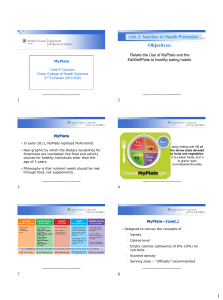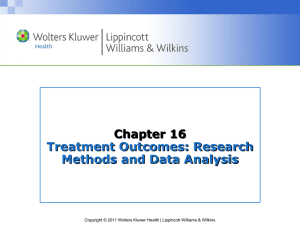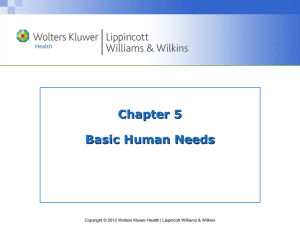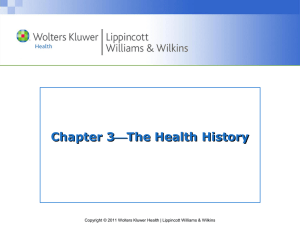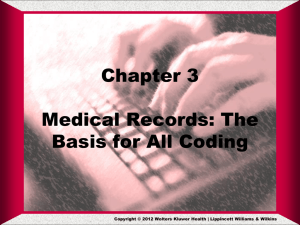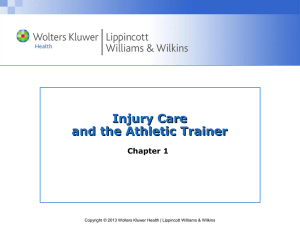LWW PPT Slide Template Master
advertisement
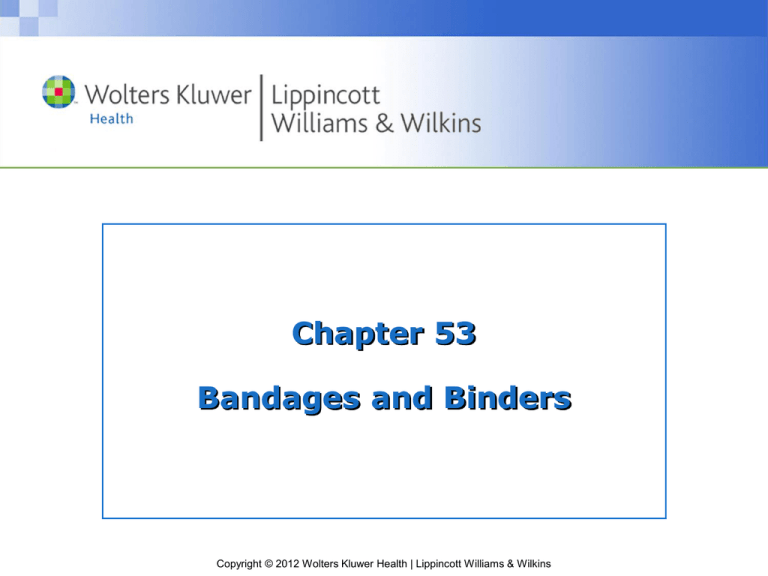
Chapter 53 Bandages and Binders Copyright © 2012 Wolters Kluwer Health | Lippincott Williams & Wilkins Bandages • Purposes and therapeutic benefits – *To support a limb or joint, a wound or incision – *To support a wound or incision – *To hold dressings, splint, cold pack or warm pack in place, or to hold a pad to absorb drainage – *To immobilize a joint or limb or maintain a limb in a specific position – *To provide compression, to promote venous return or prevent edema or prevent contractures – To shape a stump before fitting a prosthesis – *Wrapped around a clients limbs to provide muscle or joint support or to increase or support circulation Copyright © 2012 Wolters Kluwer Health | Lippincott Williams & Wilkins Wrapping of Bandages • Type of application – Figure eight – Spiral – Spiral-reverse – Circular – Recurrent Copyright © 2012 Wolters Kluwer Health | Lippincott Williams & Wilkins Peripheral Neurovascular Assessment (PNA) • Peripheral neurovascular assessment (PNA) • Observations (CMS-ET) – Color of toes or fingers – Motion or mobility – Sensitivity or sensation – Edema and swelling – Temperature Copyright © 2012 Wolters Kluwer Health | Lippincott Williams & Wilkins In Practice: The Client’s Circulation When Using Bandages Refer to Data Gathering in Nursing 53-1 CMS-ET Copyright © 2012 Wolters Kluwer Health | Lippincott Williams & Wilkins Types of Bandages • Roller bandages – All cotton elastic (ACE) bandage • Usually provides support • Hold a dressing in place • Exert pressure over a bleeding point • Kerlix-stretchy gauze • Stretch-net bandages-tube gauze Copyright © 2012 Wolters Kluwer Health | Lippincott Williams & Wilkins Antiembolism stockings – Thromboembolic disease (TED) stockings – To promote adequate return circulation and prevent clots – Remove the stockings at least once every 4-8 hours ad examine the leg carefully for redness, pitting edema, or skin discoloration – Nursing procedure 53-1 Copyright © 2012 Wolters Kluwer Health | Lippincott Williams & Wilkins Nursing Care Guideline 53-1 • Applying roller bandage – Use correct size – Elevate extremity to be wrapped just above the level of the clients body – Overlap each layer about ½ the width of the previous strip – Check the clients peripheral neurovascular status at least every 2 hours Copyright © 2012 Wolters Kluwer Health | Lippincott Williams & Wilkins The PCD Machine • To provide alternating pressure to the legs – Pneumatic compression device (PCD) – Sequential compression device (SCD) – Intermittent sequential compression device (ISCD) • These machines support circulation and are used primarily for clients immediately after surgery and for those with circulatory disorders. Copyright © 2012 Wolters Kluwer Health | Lippincott Williams & Wilkins The PCD Machine Copyright © 2012 Wolters Kluwer Health | Lippincott Williams & Wilkins Binders • Binder – Wide, flat piece of fabric that is applied to support a specific body part or to hold a dressing in place. – Arm sling – T-binder • Used to hold rectal or perineal dressings in place – Breast binder – Abdominal binder • Flat piece of fabric that is secured around the trunk of the clients body to support the abdomen or dressings on the abdomen Copyright © 2012 Wolters Kluwer Health | Lippincott Williams & Wilkins Applying a binder • Nursing care guidelines 53-3 – Apply firmly but not to tight – Fasten the binder from the bottom up – Rewrap binder every 2-4 hours and check the dressing Copyright © 2012 Wolters Kluwer Health | Lippincott Williams & Wilkins Hypoallergenic Tape • Holds a client’s dressings in place • Supports sprained ankles, fractured ribs, or fractured toes • Allows ventilation and helps to prevent skin maceration (skin breakdown) Copyright © 2012 Wolters Kluwer Health | Lippincott Williams & Wilkins Montgomery Straps • May be used if frequent dressing changes are needed • Helps prevent skin irritation Copyright © 2012 Wolters Kluwer Health | Lippincott Williams & Wilkins Montgomery Straps Copyright © 2012 Wolters Kluwer Health | Lippincott Williams & Wilkins

